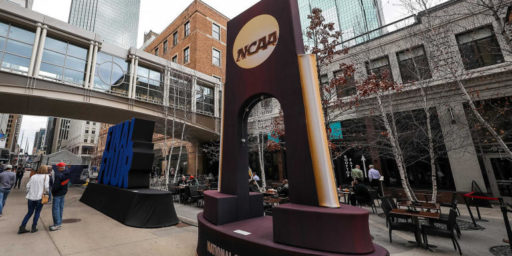Why Athletes Graduate at Higher Rate Than Other Students
Contrary to popular belief, college athletes graduate at a much higher rate than other students.
Contrary to popular belief, college athletes graduate at a much higher rate than other students.
AP (“NCAA: latest graduation rates best ever“):
The NCAA released its annual report on graduation rates Tuesday and proudly declared that college athletes are earning degrees at record rates and outpacing their fellow students by nearly all measures.
For the first time the graduation rate for both the one-year snapshot of incoming freshmen (in 2004-05) and the four-class measure (covering the years 2001-04) hit at least 80 percent. The one-year score was 82 percent, bettering the record 79 percent from the previous three reports. The four-year average was 80 percent, breaking the previous all-time high of 79 set in 2009 and matched in 2010.
[…]
NCAA president Mark Emmert and others believe the results are a direct reflection of the NCAA’s academic reforms.
In 2003 the NCAA changed the eligibility requirements for incoming freshmen and college upperclassmen. It required high school seniors to complete 16 core courses and upperclassmen to finish a higher percentage of course work toward a degree to remain eligible.
“It’s an incredible move,” Emmert said. “It seems to be very broad-based. … This type of progress doesn’t happen overnight.”
Though reaching the 80 percent plateau is a milestone achievement, the push is on to do even better.
In August, Emmert got the board of directors to approve tougher penalties for teams that don’t make the grade on the annual Academic Progress Report, which is released in the spring. Teams that fail to make a higher benchmark could even be banned from postseason tournaments.
Rodger Payne, a professor of political science at Louisville, thinks it’s because athletes get help not available to other students:
It would seem that an athletic scholarship solves many of the problems identified by the academic studies explaining low graduation rates. After all, many athletes are on scholarship. According to the NY Times in March 2008, the NCAA reported nearly 140,000 division I and II scholarships in 2003-2004. The average amount of funding was just over $8400 — or $10,400 with football and basketball included in the count. That’s far from a full-ride, but it undoubtedly reduces economic pressure on those athletes and their families. Sure, student-athletes have to “work” by putting in many hours practicing and competing, but this effort involves a voluntary extracurricular activity that they might enjoy. It has to beat a part-time job at the UPS shipping hub, which is where many Louisville students work.
Second, athletes often have access to academic tutors, regular meal plans, and other perks that regular students do not have. Someone in the Athletics Department sends every instructor multiple messages during the academic term to make sure that student-athletes are performing well enough in classes to remain eligible for competition. Surely that alters the cultural experience for these athletes and helps assure institutional “accountability”
My sense is that, while these things matter at the margins, we’re mostly dealing with a false comparison here.
First, the NCAA eligibility requirements, which are barriers mostly to football and men’s basketball players, keep out students without the scholastic preparation and aptitude to attend college. At all but the most selective institutions, this doesn’t happen for non-athletes. That means that a lot of students fail after their freshman year and drop out of school.
Second, while football skews the numbers a bit because of the size of the teams and the visibility of that sport, the fact of the matter is that most college athletes are involved in non-revenue sports like golf, swimming, tennis, gymnastics, lacrosse, crew, rugby, and the like. They’re typically highly motivated individuals from well-off families. So, again, we’re talking about a more competitive pool than the non-athlete comparison group.
Third, as Payne mentions, a lot of athletes are on scholarship. Shouldn’t we then compare them to other scholarship students rather than to the general population?
Additionally, in addition to the financial and academic support Payne discusses, another benefit that athletes have over non-athletes is a sense of belonging and purpose. If they’re struggling in their classes, they’ve got a really powerful reason to fight through it and stay in school: their love of competition, the camaraderie of the team, and so forth. They’ve also got a built-in network of friends and adult mentors to ease the transition.







I agree the mixing all the sports together is big part of the explanation here.
But I think you overlook the minimalist academics the football/basketball players tend to take. There was a recent story on the types of degrees these players pursued, they tended to be physical education and communication degrees, and not, for example, if you are going to a school with a prestigious engineering program, an engineering degree. And at least where I went to school, everybody knew what the “jock” courses were.
@PD Shaw: But that actually only matters on the margins. Few students fail out of school because of courses in their major; they tend to select majors based on their aptitudes. No, what gets them is the core curricular requirements. Jocks can’t skate on those.
Hmm, let’s see:
A more regimented lifestyle. Far more of a goal-oriented demographic. A higher level of maturity, both physically and mentally. Less time on the Internet. Fewer bong hits. Less time watching “Jersey Shore” and “The Daily Show.”
To my way of thinking the surprise if anything is that the spread in graduation rates is not larger.
There are many varying reasons why this happens and yes how you choose the parameters for comparisons could change the results. For example I agree with your many freshman drops out after their first year. Take out the freshmen class and I suspect the number would be a good deal closer.
However comparing them to other scholarship students instead of the general population would be unfair. Many of the other scholarships are often given to the cream of the crop in academically and disposition. Athletic scholarships even though they look at those qualities are far more concern with athletic performance.
Re “They’re typically highly motivated individuals from well-off families”
They are typically highly motivated in that sport. I’m not sure where you get that they are typically from well-off families. I was from a division II school and “most” of us were not from well off families. Most of those that I knew in division I athletics didn’t fit that criteria either.
And down falls another of the “improvements” brought on by the Woodstock generation. So college kids need structure, curfews, regimentation and accountability to an adult. Kind of like college before 1965.
It does seem though that incoming freshmen could benefit from, let’s call it, a plebe summer. Bring them in early, keep them moving as a unit, perhaps push them through a writing class or something. Give them time to get used to mommy not being around, to shaking off the eat/regurgitate that is their education up to then. Then they start classes and by that first Christmas, there could be slow individual movements out of the regimentation program based on real assessment of adaptation.
Wonder if there are any Frank Ryans in that cohort?
Sorry, wrong thread.
Wow.
Seriously?
I’m sure that the rest of those institutions not among the “most selective” can breathe a little easier, knowing that they can get rid of those “Admissions Departments” that keep up the ruse of screening potential students for aptitude, academic preparedness and the like.
Maybe you want to re-think that one?
I don’t know about sports like football, basketball and maybe even baseball, but other sports costs serious green. I know about swimming and for that we are talking well over $2000/year/child and that is for a good swimmer, not a great one (i.e. the bigger the swim meets the more that they cost). You’ve got team dues (right now ours is around $90/month), often time a “booster fee” (several hundred bucks there, heating a pool is not cheap), suits (yes multiple and they aren’t cheap either and the better the swimmer the more expensive the suit), then there meet fees, cap, goggles, you’ll likely have to donate dozens of hours to the team, then there are things like gas, hotels for some meets and so forth. Most of the kids on these teams are going to come from fairly well off families, maybe not rich, but certainly middle class. I wouldn’t be surprised if a team in Southern California pulls in over $150-200k/year in revenue, even for a mid sized team of 150 swimmers. And that is a just a “club team” not high school and not college and that is where the U.S. get almost all of their Olympic caliber swimmers.
@CJ Robinson: The vast majority of American colleges and universities are essentially open admissions. Almost all state schools, aside from flagship institutions, will let in essentially anyone with a high school diploma or GED.
NCAA athletes, on the other hand, have to meet certain grade point average and standardized test score benchmarks in addition to the minimum standards of the institution.
@Steve Verdon: Yup. And swimming is relatively cheap compared to golf, tennis, crew, and some other sports where there only teams are in elite private schools or pricey private clubs.
@James Joyner:
Don’t kid yourself. The NCAA requirements are little more than a GED and a pulse themselves. A C+ average (2.3 gpa) and a 30th percentile SAT score (900 combined Verbal/Math) is enough to qualify on the sliding scale for DI, even lower for DII (2.00 GPA and an 820). They’re not screening for scholars, just making sure that schools don’t recruit athletic non-students entirely in bad faith. It’s value as a gatekeeping function as compared to regular students is essentially NIL.
Never mind the fact that open enrollment is only common in 2 year junior colleges and community colleges, and is the exception at 4 year schools. Not nearly as prevalent as you imply (though I do note the weasel-word “essentially”), so your snotty reply in defense of your initial logic is even more embarrassing for you. Maybe the schools you’ve taught at have such lax standards, but apparently that applies to their faculty as well, eh big guy?
Luckily for you, running OTB doesn’t require meeting any such aptitude standards. So carry on.
@CJ Robinson: Outside of the research universities (i.e., PhD-granting institutions), state schools typically have next to no barriers to admission. They’ll admit high school graduates or even GED certificate holders and offer remedial courses for math and English. That’s been true for as long as I can remember–going back 25 years or more.
@Steve
My personal experience has been with wrestling and football at college level. I had additional good deal of interaction with baseball, girls’ softball, track, basketball, gymnast and tennis at that level. There were some that were from well off families but the vast majority were not. I got the same impression from other colleges’ athletes that I interacted with. Yes I understand that one should be careful from drawing too much from personal experiences but that goes both ways.
Yes one can spend a good deal of money on a sport. It is almost impossible not to do so in some sports. However you shouldn’t mistake can with have to. When I boxed as a kid we did it on the cheap. We work out in an old unheated building. We would travel a long way to and from tournaments on a single day. If we did crash somewhere it would be at someone’s house or 15 of us per hotel room. I pretty sure that a fair portion of my group weren’t even legal residents. On the other side I knew gymnast who spent more money on one kid did we did on our whole club. However there were many poor kids in sports as a whole than there were rich ones. Certain sports would be consider rich kids sport like swimming and other like boxing were not. There is nothing wrong with either sport.
Congrats, you’re cynical about the admissions process. Not, you know, pointing to anything empirical, but you think there’s no screening going on. I’ll even let you use that as an assumption.
Let’s get back to your original point, that the NCAA requirements were somehow stringent enough to weed out all of these kids “without the scholastic preparation and aptitude to attend college.” Even granting your piss-poor assumption about the state of college admissions, the gatekeeping function of the NCAA rules has little effect.
Now, just do a little thought experiment, and explain how a kid who doesn’t meet those minimal NCAA requirements (2.00 GPA, 800 SAT) would meet even your most lax assessment of collegiate entrance requirements. (Tell you what. Before you answer that, I’ll even make it easier on you to see your mistake: How many high schools allow you to graduate with a sub 2.00 GPA?)
Your initial point is worthless.
Depends. I don’t know what the ruling body/bodies for boxing are like, but I do know that you cannot practice in a pool that is not heated in swimming. That is probably the biggest cost for swimming (although I don’t know about coaching salaries).
For gymnastics you’ll need equipment and that will cost. Then you’ll need a place to put that equipment and that will cost. Then you’ll need insurance and that will cost. Those are big costs before you even get into coaching staff and what not. And unlike swimming I bet you can’t have kids running all over the place at the same time doing stuff. Swimming you can have swimmers follow each other with just a few seconds lag time, in gymnastics in many cases I could see that having very bad outcomes. So team/group sizes might be smaller which would raise the cost per athlete.
Welcome to the paranoid age of the sex offender registry and other dubious aspects of our society that make this pretty much impossible now. Teams have to be wary of all sorts of legal problems this could cause.
Yeah, that is probably true, but I would think that many sports are more costly now vs. back 20 or 30 years ago and that is even true for sports that weren’t “rich kid sports”. It is probably more true for those sports where training time is much earlier (e.g. swimmers often start around ages 5/6, not many boxers are going to start at that age, probably same with wrestling and probably true for many in football as well).
@Steve Verdon: That sounds about right ($2000) for a moderately competetive club team. My experience is soccer as I referee the local club soccer leagues.
For middle schoolers, figure $1,000 per outdoor season in club fees (2 seasons per year), another $200 to $400 per indoor session (1 to 3 sessions per year), 2 to 4 out of region/multiple overnight stay tournaments, 3 pairs of cleats, 2 pairs of turfs, uniforms etc.
And that is before there is any significant sorting, just kids who are adequately atheltic and interested in playing half decent soccer.
Now moving onto a good U-16 player, they’re playing Olympic Development Program (ODP), most likely a local club league and a Regional league (Region 1 is New England, New York, New Jersey, PA, DE, MD), and getting additional coaching, so hitting $5000 to $10,000 a year is not that hard.
@Steve sounds like we are not that much in disagreement.
The boxing clubs where I live at now are still mainly compose of poor participates. Most of the clubs are nicer than when I grew up due mainly to sponsorships. We did have one club that practice in the National Guard Armory until someone complained. It is still easy to train on the skinny. Two pair of gloves and an opponent is all you need. Throw in a heavy bag, speed bag, jump ropes and a good coach who works for free and you have a decent facility. Entry fees and travel expenses are still issue but you don’t have to hit them all. There are many who turn successful pro from around here so they must be doing something right. One that I know who was taken from his family and bounced around the foster care system.
Most of the our organizers still treat it as personal sacrifice instead of a business so that makes a big difference. Some still pack the hotel rooms and such. Illegals around here are still common. Those who have very little, usually don’t worry about being sued all that much.